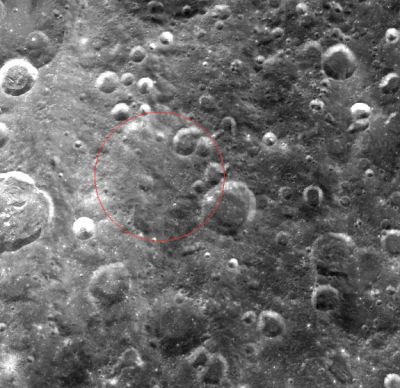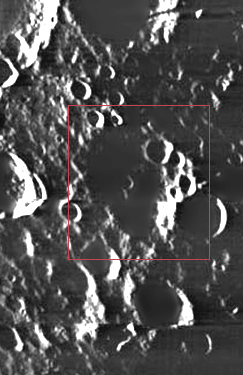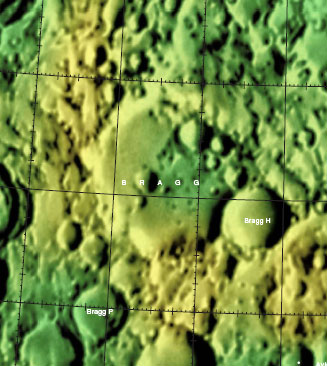Difference between revisions of "Bragg"
| Line 18: | Line 18: | ||
''([[LAC%20zone|LAC zone]] 36A3)'' [http://planetarynames.wr.usgs.gov/images/Lunar/lac_36.pdf USGS Digital Atlas PDF]<br /> <br /> | ''([[LAC%20zone|LAC zone]] 36A3)'' [http://planetarynames.wr.usgs.gov/images/Lunar/lac_36.pdf USGS Digital Atlas PDF]<br /> <br /> | ||
==Description== | ==Description== | ||
| − | '''Bragg''' is a crater of the [http://the-moon.us/wiki/Stratigraphy pre-Nectarian] period (~ 4.6 to 3.92 bn years) and lies just south-east to the [http://the-moon.us/wiki/Lorentz Lorentz Basin] -- a 365 kilometre-wide basin of the same period. The crater's rim is well-worned down through age, and several impacts have re-shaped it beyond your regular, circular-looking crater -- particularly on its eastern section where subsequent craters have formed (the largest being '''Bragg H'''). The floor region hasn't escaped impacts either, with just one relatively large craters (~ 15 km across) in the centre, and several others on a more smaller scale all around.<span style="font-family: Arial"><span class="membersnap">- | + | '''Bragg''' is a crater of the [http://the-moon.us/wiki/Stratigraphy pre-Nectarian] period (~ 4.6 to 3.92 bn years) and lies just south-east to the [http://the-moon.us/wiki/Lorentz Lorentz Basin] -- a 365 kilometre-wide basin of the same period. The crater's rim is well-worned down through age, and several impacts have re-shaped it beyond your regular, circular-looking crater -- particularly on its eastern section where subsequent craters have formed (the largest being '''Bragg H'''). The floor region hasn't escaped impacts either, with just one relatively large craters (~ 15 km across) in the centre, and several others on a more smaller scale all around.<span style="font-family: Arial"><span class="membersnap">- JohnMoore2</span></span><br /> <br /> |
==Description: Wikipedia== | ==Description: Wikipedia== | ||
[http://en.wikipedia.org/wiki/Bragg_(crater) Bragg]<br /> <br /> | [http://en.wikipedia.org/wiki/Bragg_(crater) Bragg]<br /> <br /> | ||
Latest revision as of 21:03, 16 April 2018
Contents
Bragg
| Lat: 42.5°N, Long: 102.9°W, Diam: 84 km, Depth: km, Rükl: (farside) | ||
Left: Annotated Clementine image from PDS Map-A-Planet. Middle: Annotated Lunar Orbivter V-008-M image from the LPI. Right: Colo-coded LAC 36 image from the USGS Digital Atlas.
Images
LPOD Photo Gallery Lunar Orbiter Images
Maps
(LAC zone 36A3) USGS Digital Atlas PDF
Description
Bragg is a crater of the pre-Nectarian period (~ 4.6 to 3.92 bn years) and lies just south-east to the Lorentz Basin -- a 365 kilometre-wide basin of the same period. The crater's rim is well-worned down through age, and several impacts have re-shaped it beyond your regular, circular-looking crater -- particularly on its eastern section where subsequent craters have formed (the largest being Bragg H). The floor region hasn't escaped impacts either, with just one relatively large craters (~ 15 km across) in the centre, and several others on a more smaller scale all around.- JohnMoore2
Description: Wikipedia
Additional Information
Nomenclature
Sir William Henry; Australian physicist; Nobel laureate (1862-1942).
LPOD Articles
Bibliography


